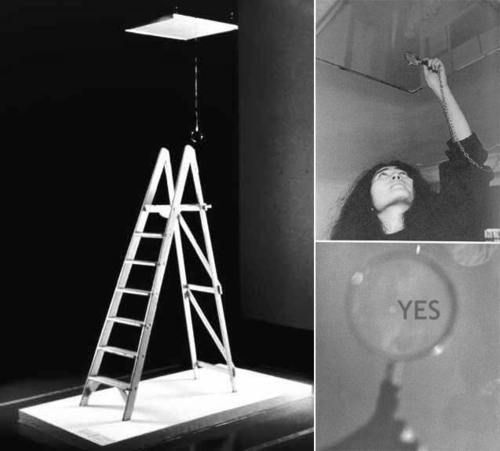
In the early 1960’s, Yoko Ono (1933-) was a young New York City artist who lived in a cheap loft on Chambers Street. She gained notoriety for her artworks like Ceiling Painting: a white ladder leading to a picture frame hung up on the ceiling that displayed one very small, three-lettered “YES” to be viewed with a dangling magnifying glass.
In New York, she joined Fluxus, a group of artists with clever ways and said to be both zany and Zen-y. They did installations in shop windows and built fun-house mazes. One member dipped his head in paint and drew with it. One handed out written instructions, suggesting that the recipient light a match and watch until it went out.
Some of Ono’s pieces exposed a destructive edge. In Smoke Painting, she presented a canvas and invited people to burn it. In Cut Piece, an example of early performance art, she sat passively on a stage as people snipped off her clothes.
She optimistically designed a vending machine to dispense bits of sky. Her Box of Smile was a hinged box with a mirror inside. Another piece, from 1960, encouraged her audience to think the word “yes,” preferably all the time.
Sometimes optimism irritates those who don’t share it. In this case, critics publicly criticized artists Yoko Ono and John Lennon (1940-1980) for their positive thinking.
But it was optimism that brought them together, when in 1966, Lennon went to see Ono’s show at the Indica Gallery in London and climbed the ladder to see the Ceiling Painting. “I felt relieved,” he said later. “It’s a great relief when you get up the ladder and you look through the spyglass and it doesn’t say ‘no’ or ‘f*** you’ or something. It said ‘yes.’ “
He asked to meet the artist. Ono didn’t know who he was, but the gallery owner prodded her to “say hello to the millionaire.” She handed him a card printed with the instruction “Breathe.” After seeing him around town a few times, she gave him a book she had done, which he kept next to his bed. They wrote each other letters and stayed up late talking.
After they became a couple, they collaborated on optimistic projects, from their famous bed-ins to a concept of a country they created called Nutopia. Skeptics and critics were critical but it never stopped the couple from being creative. “Some critic recently commented on us, John and I, as being lollipop artists who are preoccupied with blowing soap-bubbles forever,” Ono wrote. “I thought that was beautiful.”
YES—a beautiful and possibly artistic word used to express willingness or agreement and that is exactly what Yoko and John would have been deliriously optimistic about.

